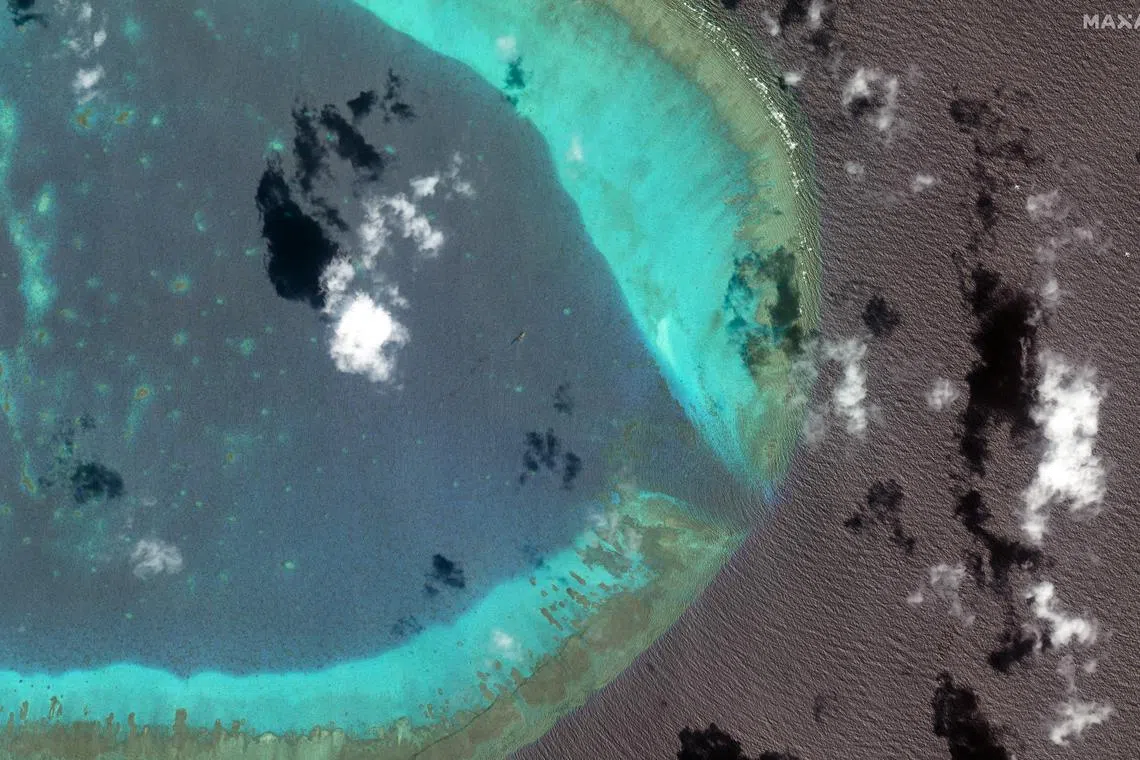Philippines ‘strongly protests’ against China plan to create nature reserve in disputed shoal
Sign up now: Get ST's newsletters delivered to your inbox

Chinese H-6 bombers flying at the eastern edge of the disputed Scarborough Shoal in the South China Sea on March 24.
PHOTO: REUTERS
Follow topic:
MANILA – The Philippine Foreign Ministry said on Sept 11 that it “strongly protests” against China’s plan to create a national nature reserve in the Scarborough Shoal,
China has approved the creation of a national nature reserve at the disputed Scarborough Shoal. The designation was an “important guarantee” to preserve the atoll’s ecosystem, China’s State Council said.
China’s plan was “patently illegal” and less about environmental protection and more about justifying control over the disputed shoal, Philippine National Security Adviser Eduardo Ano said.
“It is a clear pretext towards eventual occupation,” he said in a statement.
“The Philippines will be issuing a formal diplomatic protest against this illegitimate and unlawful action by China as it clearly infringes upon the rights and interests of the Philippines in accordance with international law,” the Foreign Ministry said in a statement.
Manila also called on Beijing to withdraw the designation and comply with international law, including the 1982 United Nations Convention on the Law of the Sea.
Manila’s Foreign Ministry said it has sovereignty and jurisdiction over Scarborough Shoal, which it calls Bajo de Masinloc, describing it as a “longstanding and integral part” of the Philippines.
Asked about Manila’s comments, China’s foreign ministry said it did not accept the “unreasonable” accusations and “so-called” protests from the Philippines.
China urges the Philippine side to “effectively stop the relevant infringement, provocation, and wanton hype, and avoid complicating the maritime situation”, ministry spokesperson Lin Jian told a regular press conference.
Prof Jay Batongbacal, an expert on maritime affairs and the law of the sea at the University of the Philippines, said China’s action was a thinly veiled attempt to tighten Beijing’s claims in the contested waters of the South China Sea.
He said it could also open the door to more aggressive tactics, including the arrests of Filipino fishermen.
China hopes that by “clothing its actions as ‘environmental protection’ they will be able to dissuade countries from supporting Philippine activities and attempts to reintroduce traditional fishing on the shoal”, Prof Batongbacal said.
Disputed sovereignty
Sovereignty over the Scarborough Shoal has never been established. A landmark 2016 international court ruling on the South China Sea, which voided Beijing’s sweeping claims to the region, was not tasked with establishing ownership.
But the court said China’s blockade of the shoal violated international law and that the area was a traditional fishing ground for several countries, including the Philippines and Vietnam. China rejected the ruling.
The reef’s northeast rim, where China intends to impose environmental restrictions, is the same area most commonly accessed by Filipino fishermen because it is sheltered from currents and waves, Prof Batongbacal said.
The shoal, named Huangyan Island by Beijing and also known in the Philippines as the Panatag Shoal, has been occupied by China since 2012 and has been a hot spot in a long-running dispute over the South China Sea between the two countries.
Both countries claim sovereignty over the shoal, a strategically located atoll and prime fishing patch close to major shipping lanes.
China claims almost the entire South China Sea as outlined on maps by the “nine-dash line”, which cuts into parts of the exclusive economic zones (EEZs) of Brunei, Indonesia, Malaysia, the Philippines and Vietnam. Beijing in November last year also defined a baseline of territorial waters around the disputed Scarborough Shoal.
Beijing, which has built manmade islands on top of other reefs in the South China Sea, some with missile systems and runways, has denied harming marine ecosystems in the region and has accused the Philippines of the same. Manila rejects that.
A 2023 report by the Centre for Strategic and International Studies found China’s construction activity buried more than 1,861ha of reef. In addition, giant clam harvesting by Chinese fishermen damaged another 16,353 acres of coral reef.
The environmental dispute has become another flashpoint in the long-running territorial row between China and US ally the Philippines in the South China Sea, a conduit for more than US$3 trillion (S$3.85 trillion) in annual ship-borne commerce.
“Our complaints and exposure of their destructive activities have been among the most effective in getting non-regional states to listen to our side,” Prof Batongbacal said.
In August, a Chinese navy vessel collided with a China coast guard vessel,
China’s move to declare the disputed shoal a nature reserve “does not bode well for maritime cooperation,” Prof Batongbacal said. REUTERS

